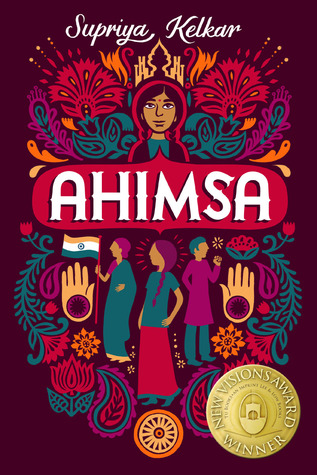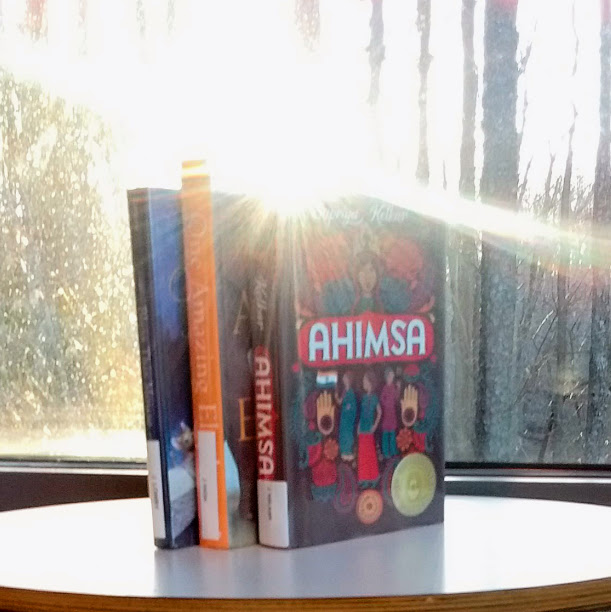Today I am delighted to share Ahimsa, by Supriya Kelkar, with you all! A truly moving story about social injustice and Ahimsa–non-violent–protest, this book is set in India in the 1940s, and will wring your heart out. 
I believe this was one of my library-browse books, but it also feels like someone within the MMGM circle recommended it. Please forgive my faulty memory if that’s the case, and provide a shout out in the comments if you tipped me to it! I’d love to thank you. <3
The story follows Anjali as she learns that her family will be heeding Gandhi’s request that every family give one member of their family to the freedom movement. In Anjali’s case–and much to her surprise–it is her mother who will be joining the movement. What this translates to in practical terms is her mother standing up to the British Government first by quitting her job as a secretary, then encouraging her family to give up all their beautiful foreign-made clothes, while her mother learns to make homespun clothes. Additionally, as part of the internal effort to bring the people of India together, Anjali’s mother reaches out to the ‘untouchables’ of the dalit caste as she works to improve their opportunities in life. Finally, her mother’s journey results in her being taken to jail, where Anjali worries that she will die.
The subjects the book addresses are super tough. In fact, while the particulars are unique to India and this time, they are all problems readers can readily identify with–and many children face to one degree or another. Racial, societal, and religious prejudice. Societal-supported unfairness. Social isolation if you disrupt the status quo. Deeply entrenched behaviors that will not easily change. Repercussions if you fight–even in non-violent ways–for change. All we need do is go online or watch the news, and this story’s relevance is immediately apparent. However, one of the reasons for the book’s success is that it is also highly readable and personally relatable. Anjali and her family do not feel like icons, but individuals. So, too, the other members of the book who for the most part felt very well-rounded. Additionally, I loved that the book is honest about the complicated nature of bringing about social change. That there is rarely one clear answer, with viable arguments and concerns on both sides and sometimes disagreements within those striving for change. In fact, at one point Anjali begins to wonder if the end result will be worth the cost to those she is trying to help, though thankfully she perseveres.
All that said, I think many students will need encouragement in order to push past some initial challenges and keep reading Ahimsa. The first snag is simply that the book is a full-immersion experience, so some middle grade readers may have a difficult time sorting out the different customs and new words. Additionally, the style of the writing–while beautiful–is a little formal and may not welcome some readers in initially. And finally, in the beginning Anjali herself appears a little spoiled and self-absorbed. She’s not even nice to her mother. I’m glad she is shown this way, since it’s an honest look at who she was and allows for the full triumph of her character arc, but readers may find her less sympathetic initially.
However, this book is one of those super rare times where I recommend teachers and parents provide the push kids might need to pick Ahimsa up and work through it. For one thing, any challenge it may prove will pay off in the impact it will have on their life. For another, I’m confident that even the most reluctant reader will find themselves swept up in the glory of the emotional finish, and LOVE the ending! It’s rare that a book is truly for everyone and needs to be read universally–but that’s my recommendation. I found Ahimsa a truly a light-giving book.

As an aside, many thanks to my patient local librarians, who never look askance when I pose books in our library’s beautiful big windows. 🙂
Now, let’s see what Apricot-kitty’s reaction was:
 “What an interesting place, where a common cow could be held in such reverence and respect…and where, moreover, the cow would seem to be worthy of their respect.”
“What an interesting place, where a common cow could be held in such reverence and respect…and where, moreover, the cow would seem to be worthy of their respect.”
Ah, yes. A spotlight on the book would not be complete without mentioning Nandini, Anjali’s beloved friend of the bovine persuasion. I thoroughly enjoyed the symbolism surrounding her, and the crucial role the sweet family cow plays at a pivotal moment in the story. A cow truly worthy of a cat’s admiration!
I hope you all had a wonderful St. Patrick’s Day, and are staying warm as this winter lingers! For more Marvelous Middle Grade Monday reviews, interviews, spotlights and giveaways, stop by Greg Pattridge’s blog, and happy reading!

Natalie Aguirre
Suzanne
Greg Pattridge
Suzanne
Patricia Tilton
Suzanne
Danielle Hammelef
Suzanne
Rosi Hollinbeck
Suzanne